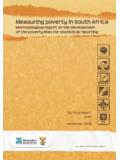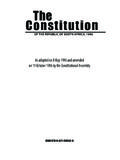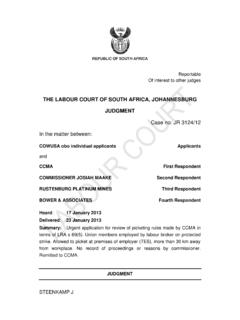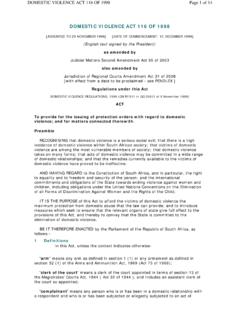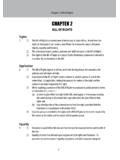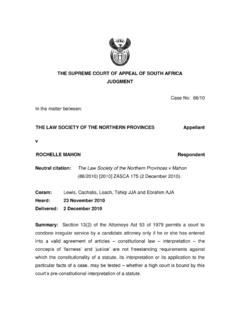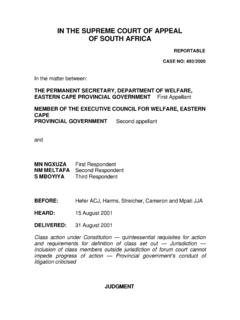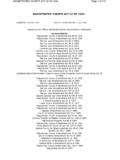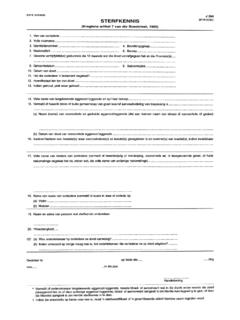Transcription of Reportable Case No 5/2002 - justice.gov.za
1 Reportable Case No 5/2002 . In the matter between: SOUTH AFRICAN FOOTBALL ASSOCIATION Appellant and STANTON WOODRUSH (PTY) LTD. t/a STAN SMIDT & SONS First Respondent THE REGISTRAR OF TRADE MARKS Second Respondent Coram: HARMS, SCHUTZ, BRAND, CONRADIE JJA and HEHER AJA. Heard: 18 NOVEMBER 2002. Delivered: 27 NOVEMBER 2002. Subject: Trade marks; Bafana Bafana in relation to clothing; rectification of register; procedure. JUDGMENT. HARMS JA/. 2. HARMS JA: [1] The national soccer team had the nickname Bafana Bafana1 thrust upon it during 1992, first by the press and thereafter by the public. The appellant, the South African Football Association ( SAFA'), manages, administers, controls and selects the team. After some years of hesitation and reluctance, SAFA. adopted the name as a commercially valuable appellation for the team. Believing now that it is the true proprietor and the holder of all the trade mark and other intellectual property rights in and to' the name, it claims to have committed itself to the exploitation of its rights by means of an extensive licensing and merchandising programme.
2 For instance, it embarked on an ambitious campaign of registering as a trade mark the name Bafana Bafana by itself and also in association with different logos on virtually all goods and services and in practically all classes under the Trade Marks Act 194 of 1993. ( the current Act'). Presumably, as a result of all this the public in due course 1. It means The Boys, The Boys'. 3. will be able to purchase even Bafana Bafana manure, artificial limbs and eyes and teeth or use Bafana Bafana beauty care and legal services. [2] The cause of this litigation is the fact that the first respondent, ( Stanton'), holds a trade mark registration 93/0581 for word mark Bafana Bafana in class 25 in respect of clothing (including boots, shoes and slippers). Dissatisfied with this state of affairs, SAFA applied to the Transvaal Provincial Division on notice of motion for an order removing the mark from the Register of Trade Marks and directing the Registrar to rectify the register Spoelstra J in the Court below dismissed the application on the ground that SAFA was not an interested person' within the meaning of the term as used in s 24(1) of the current Act: only an interested' party has legal standing to seek this relief.
3 Consequently he found it unnecessary to deal with the multi-pronged attack by SAFA on Stanton's registration. Later he granted leave to appeal and before us 2. The Registrar, cited as second respondent, elected to abide the decision of the Court. 4. counsel for SAFA argued the case on fewer grounds than those foreshadowed by the papers. [3] Before turning to the remaining grounds of attack, some preliminary matters have to be dealt with. Stanton's application for registration of the trade mark was made under the repealed Trade Marks Act 62 of 1963 ( the old Act'). on 28 January 1993, which date is the deemed date of registration of the The current Act came into effect on 1 May 1995 and contains transitional provisions4 that can be summarised as Applications and proceedings commenced under the old Act are to be dealt with under its provisions as if it had not been repealed; questions relating to the original entry of old' marks are to be dealt with under the old Act; but whether a mark should remain on the Register is dealt with in terms of the current Act.
4 3. Mars Inc v Cadbury (Swaziland) (Pty) Ltd and Another 2000 (4) SA 1010 (SCA) par 11 and 12. 4. S 3(2), s 70(1). 5. Mars Inc par 10. 5. [4] Something has to be said about the procedure adopted by SAFA in launching these proceedings. SAFA's primary attack on Stanton's trade mark is based on the assumption that Stanton is not entitled to the trade mark because it belongs to SAFA. During the course of the appeal it became clear that SAFA. was overly ambitious since, in relation to two of the three grounds persisted in, it is at best entitled to an order setting aside the act of registering Stanton's trade mark. Both these grounds are based upon the premise that when the Registrar registered Stanton's mark, proceedings concerning Stanton's application, which provided a bar to registration, were still [5] Since the present proceedings are primarily review proceedings, SAFA. should have utilised the provisions of Uniform rule SAFA chose not to do so.
5 A failure to follow rule 53 in reviewing a decision of an administrative organ is not necessarily irregular because the rule exists principally in the 6. S 37(1) of the old Act. 7. The Promotion of Administrative Justice Act 3 of 2000 was not in force when the application was launched. In any event, its regulations have not yet been promulgated. 6. interests of an applicant, and an applicant can waive procedural An applicant is, however, not entitled by electing to disregard the provisions of the rule to impinge upon the procedural rights of a If, as is the usual case, the proceedings are between the applicant and the organ of state involved, the latter can always in answer to an ordinary application supply the record of the proceedings and the reasons for its decision. On the other hand, as in this instance, if the rights of another member of the public are involved, and the organ of state, hiding behind a parapet of silence, adopts a supine attitude towards the matter since the order sought will not affect it (no costs were sought against the Registrar if the latter were to remain inactive), the position is materially different.
6 Stanton was entitled to have the full record before the Court and to have the Registrar's reasons for the impugned decisions available. As a respondent in an ordinary application it does not have those rights. 8. Jockey Club of South Africa v Forbes 1993 (1) SA 649 (A) 661E-F. 9. SACCAWU and Others v President, Industrial Tribunal, and Another 2001 (2) SA 277 (SCA) par 7. 7. [6] The lost file epidemic, moving through our legal landscape like the bubonic plague and sweeping us back into the Middle Ages, has also, it seems, infected the registry. SAFA, we are told, could not locate the file relating to Stanton's trade mark at the Registrar's office shortly before the application was launched. Nevertheless, there is no suggestion that the other relevant application files10 were not available. There is also no indication that the Registrar could not, as he would have been obliged to do, reconstruct a file with the assistance of all the parties and attorneys involved.
7 We know, for instance from the founding affidavit, that SAFA had relevant documents in its possession that do not form part of the papers. [7] The origin of the name Bafana Bafana formed the subject of a linguistic or perhaps semiotic debate, as if the average consumer or soccer fan could care. One thing though is clear and that is that three journalists at the Sowetan newspaper were the first to use the appellation in connection with the national 10. For instance those relating to the Kappa applications, about which more later. 8. team during July 1992. The nickname caught on, somewhat to the annoyance of SAFA, because some cultures regard it as derogatory to refer to a team of (sometimes married) men as boys'. Exactly when SAFA realised the value of the name is unclear. Even though there is evidence that a sponsor of the national team, SA Breweries, and the then President of SAFA referred to the team by that name shortly before Stanton filed its application, SAFA's programme of applying for the registration of trade marks commenced only some four years later during 1997.
8 [8] SAFA lays a general claim to the name Bafana Bafana and this claim requires analysis, because in order to succeed in its application SAFA, as mentioned, has to establish that it is an interested' For present purposes it will be convenient to determine that issue with reference to the question whether SAFA (or someone from whom it derived a title) had, at the 11. Under s 33(1) of the old Act the applicant had to be an aggrieved' party but nothing turns on the change in terminology. 9. time of Stanton's application, any entitlement to or legal interest in the (I do realise that, to some extent, this formulation tends to conflate the issue of legal standing with that of entitlement but it is not always possible to keep the issues apart.) Put otherwise, does Stanton's registration invade some legally recognised right possessed by SAFA?13 This debate is also relevant in the context of SAFA's attack on Stanton's mark on the ground that it was likely to deceive or confuse, an issue which presupposes some right to the name vesting in [9] The starting point is that there can be no exclusive right in a The position was well summarised by Stegmann J:16.
9 The mere fact that a person has made a name famous does not give him a right of property in the name. He cannot stop other entrepreneurs from making such use of the famous name in the marketing of their goods and services as they may be able to make without either defaming any person or causing a likelihood of confusion as to the origin of the goods or 12. Valentino Globe BV v Phillips and Another 1998 (3) SA 775 (SCA) 780J-781D. 13. Elvis Presley Trade Marks [1997] RPC 543 (ChD) 547. 14. S 16(1) of the old Act. 15. Du Boulay v Du Boulay (1869) LR 2 PC 430 quoted in Elvis Presley loc cit. 16. Moroka Swallows Football Club Ltd v The Birds Football Club and Others 1987 (2) SA 511 (W) 531E-G. 10. services. Provided that he does not commit the delicts of defamation or passing off or offend against any specific statutory prohibition, there is no reason why an entrepreneur should not take the benefit of such advantage as he may be able to gain in the marketing of his goods and services by associating them with names that have become famous.
10 '. [10] Much was made in SAFA's affidavits of its intention to merchandise the name as the basis of its entitlement to the name in preference to Stanton. If regard is had to the trade mark registration programme, the intention to merchandise the name probably arose only during 1997, but assuming that it had the intention prior to Stanton's application, the question arises as to what rights that intention gave rise to. [11] Character merchandising17 has become somewhat of a catchphrase, but as so often is the case, catchphrases tend to obscure rather than enlighten. The concept arose in the licensing of famous comic book characters, such as Mickey Mouse. But licensing the use of such characters was nothing more than a 17. On this subject and on what follows, see esp John N Adams Character Merchandising 2 ed, Kerly's Law of Trade Marks and Trade Names 13 ed par 22-42 to 22-65 and the decision of Van Dijkhorst J in Lorimar Productions Inc and Others v Sterling Clothing Manufacturers (Pty) Ltd 1981 (3) SA 1129 (T).
